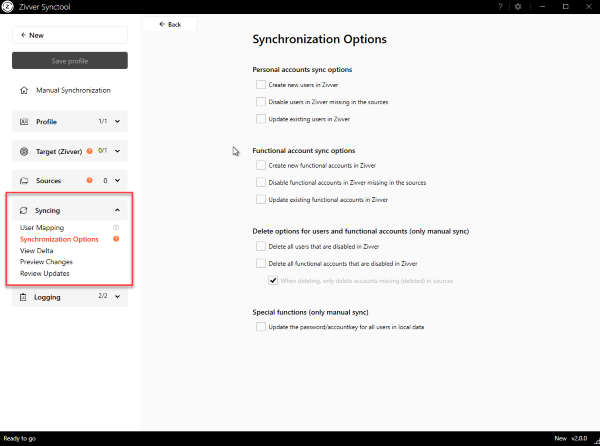I am a Zivver admin
Configure and manage Zivver
08. Synctool Syncing

Introduction
This section describes how to map your users, adjust synchronization options, view the delta between your organization in Zivver and your source, preview pending changes, and review completed updates. These functions are grouped under the Syncing tab in the Synctool user interface.
Account Mapping
Zivver needs to map users from your source to the corresponding Zivver accounts so that any changes are made to the correct accounts. In Zivver, the Internal ID is used to identify accounts.
By default, users’ email addresses are used as internal identifiers. However, if a user’s email address changes, this identifier becomes incorrect, leading to synchronization errors.
To prevent this, you can configure the Synctool to use a user account property that—unlike the email address—does not change. Using a fixed account property prevents synchronization errors when a user’s email address changes, for example, after a marriage or divorce.
This mapping information is not uploaded to Zivver. Therefore, it must be stored locally.
It’s best practice to store the Account Mapping in the same location as the Synctool. For example, if the Synctool is stored at
C:\Program Files\Zivver.Synctool, create a folder called Account Mapping, and save the Account Mapping in C:\Program Files\Zivver.Synctool\Account Mapping.Synchronization Options
At Synchronization Options, you define what actions the Synctool performs during synchronization.
Personal account sync options
Create new users in Zivver
Creates new user accounts when the source contains users that have not yet been synchronized to Zivver.
For example, when new employees join your organization.Disable users in Zivver missing in the sources
Suspends currently enabled users in Zivver when they are suspended or missing in the source.
For example, when an employee leaves the organization.Update existing users in Zivver
Updates existing users in Zivver with new or modified information.
For example, a change in name, email address, mobile phone number, aliases, or delegations.
Functional account sync options
Create new functional accounts in Zivver
Creates new functional accounts when the source contains new shared mailboxes that have not yet been synchronized to Zivver.
For example, when you create a new Exchange shared mailbox.Disable functional accounts in Zivver missing in the sources
Suspends functional accounts in Zivver when they are missing in your source. Disabling functional accounts removes all active delegations to them.Update existing functional accounts in Zivver
Updates existing functional accounts in Zivver with new or modified information.
For example, a change in name, email address, aliases, or delegations.
The Accounts page in the WebApp continues to show suspended functional accounts as Active. However, there are no active delegations to these accounts, meaning users cannot log in to the functional mailbox.
Delete options for users and functional accounts (manual sync only)
- Delete all users that are suspended in Zivver
Deletes all user accounts that are currently suspended in Zivver. Delete options can only be run manually and cannot be scheduled.
Use Delete all users that are suspended in Zivver together with Only delete accounts (functional or users) not present in sources.
If your organization suspends users for a period before deleting them from your source, combining these two options prevents Zivver accounts from being deleted while their Active Directory accounts still exist.
Delete all functional accounts that are suspended in Zivver
Deletes all functional accounts that are currently suspended in Zivver. Delete options can only be run manually and cannot be scheduled.Only delete accounts (functional or users) not present in sources
Deletes user and functional accounts only if they are both suspended in Zivver and missing in your sources. This option must be used together with Delete all users that are suspended in Zivver or Delete all functional accounts that are suspended in Zivver.
View Delta
At View delta between Source and Target, you can view the difference (i.e., delta) between Zivver (Target) and your source data.
View Delta consists of several tabs showing tables with users or functional accounts that can be changed in Zivver based on information from your sources.
Double-click any account row to view detailed information about the changes, including the data received from Zivver and from your source(s).
Click to export all tab data from View delta into an .xlsx file.
Click if you have modified your source and want to refresh the View delta information.
Preview Changes
The Preview changes next synchronization option shows whether the proposed changes would be successful.
Preview Changes consists of several tabs showing tables with users or functional accounts that were part of the trial run.
Double-click any account row to view details of the trial run.
Click to export all tab data from Preview changes into an .xlsx file.
Click if you have modified your source and want to rerun the preview.
Review Updates
At Review changes made during last update, you can review the results of the last manual synchronization.
Review Updates consists of several tabs showing tables with users or functional accounts that were synchronized.
Double-click any account row to view synchronization details.
Click to export all tab data from Review Updates into an .xlsx file.
